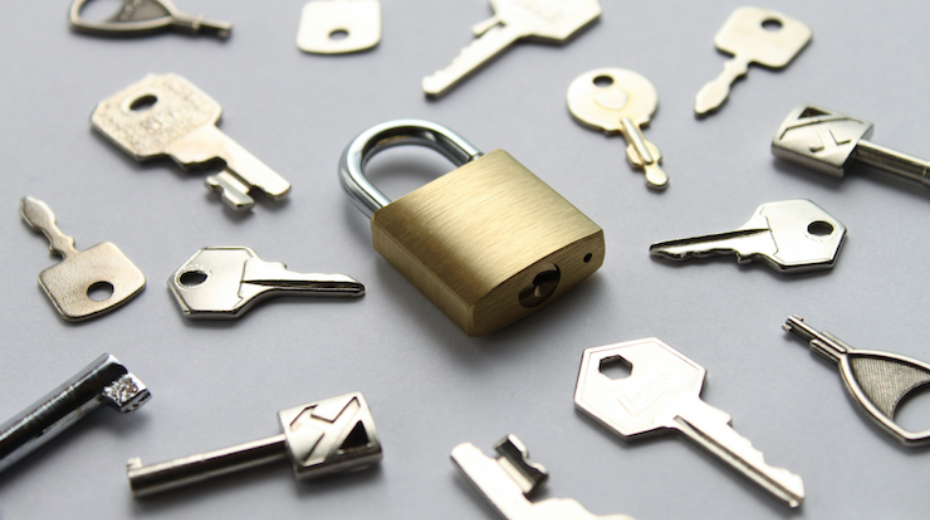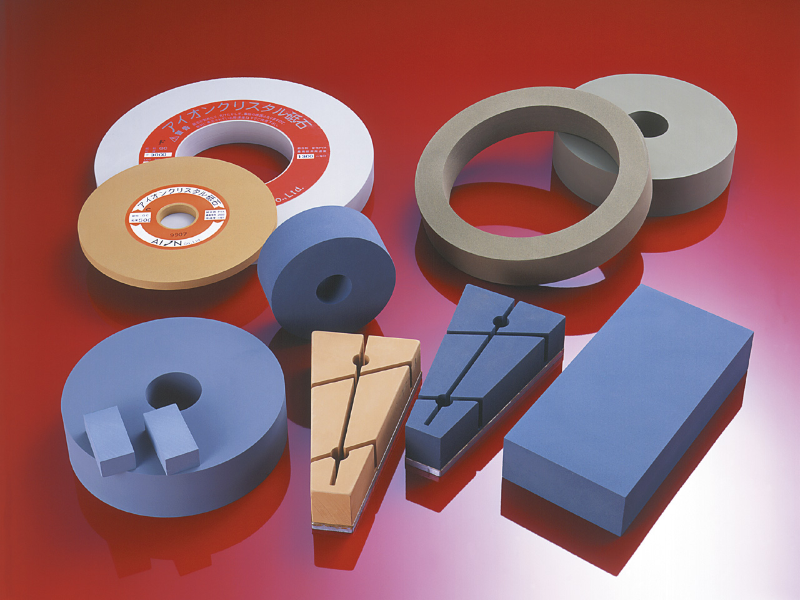
In what way should grindstones employed in abrasive working be chosen? The types and classifications of grindstones are extraordinarily numerous; mistaking the selection method not only renders the job inefficient, but is sure to invite cost increases and degradation in the accuracy of the finished product. Selection of the right grindstone is critical for efficient abrasive working. This article introduces setups whereby grindstones perform abrasive working, types of grindstones, and tips when selecting a grindstone.
Grindstone-Based Finishing and Its Effect
What sort of features are found in grindstones used for finishing?
Here we will consider the effect of grindstone-based finishing from the perspectives of what sort of process is finishing and for what objective is it carried out.
Finishing Objectives
The word “finish” means, to “give a desired or particular surface texture,” from Old French finir, “to complete.”Abrasive working is the process of changing the surface condition of a workpiece by honing and polishing, i.e. finishing, it.
Abrasive working is carried out to minimize irregularities in and smooth the surface of a workpiece.Abrasive working does not result in significant change in form; the fact that it actually scrapes away the surface of the workpiece to change its microscopic form makes it is one class of removal process.
Among removal processes, in addition to abrasive working is grinding.The two are sometimes confused, but their objectives are different.
Abrasive working is a process that focuses on smoothing.Given that the objective is to alter the surface condition, there is no significant altering of form.On the other hand, grinding operations are processes in which the focus is placed on shaving down the surface.The processes are characterized by the fact that because the amount that is shaved off is considerable, in many cases they are accompanied by a visible change in form.
Thus, abrasive working and grinding operations differ in terms of whether the objective is to “smooth” or to “shave down.”
Understanding Grindstones Used in Finishing
Abrasive working methods include those that employ grit and those that employ grindstones.Among them, methods employing grindstones are in general pervasively perceived as being used in grinding operations pervades, while abrasive machining tends to be thought of as based on grit.This may be a perception that spread at a time when grindstones could only be used for rough shaving.
Thanks to grindstone research and advances, however, grindstones that enable uniform, high-precision abrasive working are also becoming more widespread.
With conventional lapping operations employing grit, considerable time and trouble are required for pre- and post-operation preparations, and for post-processing.
Being able to replacing this sort of grit-based finishing with grindstone-based abrasive machining makes it possible to omit the pre- and post-process steps.Reducing the number of steps allows processing time and cost to be drastically reduced, and can serve to curtail lead time.
Grindstones can be formed into customized shapes, meaning that they can be installed and used on dedicated machines, which ties in to finishing job standardization.Utilizing grindstones in this way also makes high-efficiency continuous machining possible.
Mechanism to Grindstone-Based Finishing
Grit-based finishing shaves away a workpiece surface by pressing against and moving over the surface microfine grains made of a material harder than the workpiece.Well then, what sort of structural makeup does finishing in which grindstones are employed consist in?
The Three Elements that Make Up a Grindstone
The grindstone used in abrasive working may look like a single stone-like block, but when magnified, it has a special structure that allows for efficient abrasive working.When viewed under magnification, a grindstone comprises the following three elements:
・Grains
・Bond
・Pores
The balance of these three elements determines the performance of the grindstone.Let’s have a look at their respective roles.
Role of Grains
Among the three elements that make up a grindstone, it is the grains that create the gritty texture.
Each and every grain plays the role of a cutting tool.Viewed magnified, the grains are of form in which there are any number of pointed edges, and their presence on the surface of the grindstone is tantamount to the grindstone surface being studded with a myriad of fine blades.
When the grains lose their cutting cusps and their shaving power is lost, they fall out and succeeding grains appear in the surface.The continuance of the shaving power of the grindstone is thanks to this action.
For the grains, diamond, silicon carbide, or other substance that is characteristically harder than the workpiece being polished is used.
Role of Bond
Bonds possess the dual roles of retaining the grains and of adjusting the force with which the grindstone as a whole presses against the workpiece.
If grains when having lost their shaving power do not fall out at just the right time, the work cannot be kept ongoing.
If the bonding force between the bond and the grains is too strong, grains that have lost their shaving power will continue to remain in the surface.Continued rubbing by grains lacking cutting power overheats the grindstone and the workpiece, giving rise to processing failures such as damage to the grindstone, grinding burn, and deformation.
Conversely, if the bonding force is low, grindstone wear is rapid, which is inefficient in terms of tool life.Thus, retaining force that is not suited to a given role of retaining grains ties in with degradation of the finish, and of tool life.
In terms of adjusting the force with which the grindstone is pressed on the work, the rigidity of the bond has a significant impact.If the bond is high-rigidity, the pressing force of the grains intensified, making the grindstone fit for rough cutting in grinding operations.Conversely, bond having elasticity has cushioning properties, and thereby the pressing of the grains can be adjusted to be soft—meaning, therefore, that the bond is suitable for abrasive working whose objective is to alter the surface condition.
Also, the elasticity in a bond enables leveling out the tips of grains whose extent of protrusion is irregular.Uniform abrasive power thereby can be imparted to the contact surface of the grindstone, enabling smoother finishing.
Role of Pores
In the interstices between grains retained by the bond, there are any number of microfine gaps called pores.These pores are not mere holes, but have an indispensable, crucial role.
Grindstone-based abrasive working produces grinding debris after a workpiece is shaved down.Grinding debris continuing to remain between the grindstone and the workpiece diminishes the abrasive power of the grindstone, and makes both it and the workpiece grow hot.This heat invites grinding burns and deformation, proving to be a factor causing damage to the grindstone.What’s more, grinding debris can turn into large chips that come into contact with the workpiece, proving to be a factor causing scratches during finishing.
When they appear in the surface of the grindstone, pores form small grooves that, by expelling grinding debris, serve to maintain abrasive power.
At the same time, pores also have a role in bringing coolant to the finished surface to assist in cooling of the finished surface.Coolant also plays roles apart from cooling, including appropriately modulating frictional forces and flushing out grinding debris.
Thus, pores take on vital roles in preventing grindstone loading, maintaining abrasive power, and transporting coolant.
Measures against grindstone loading are discussed in detail in “Strategies for Countering Loading of Polishing Grindstones: Troubles Likely to Arise and Their Causes.”
Selecting Grindstones, and Grindstone Types
When a grindstone is chosen, what’s the type that should be selected?
Tailoring According to the Workpiece
The grindstone employed, including grindstones designed for metals, grindstones designed for wood, grindstones designed for plastic, and grindstones designed for glass, will differ depending on the material qualities of the workpiece.
Among those designed for metals, the grindstones employed are divided according to the type and hardness of the alloy that will be the finishing object, including grindstones designed for stainless steels, for other steels and iron, and for soft metals such as aluminum and copper.
Differences According to Tool/Machine in Which the Grindstone Is Employed
Grindstones directed to free finishing such as with bench grinders or angle grinders are standardized in size.
Grindstones employed in vertical polishing machines and lapping machines, being often customized to accord them to the form and material quality of the workpiece, are thus produced as ad-hoc articles.
Classification According to Base Material
As the grain and bond-matrix stock, a variety of materials are used.
Grindstones using such materials as alumina, silicon carbide, diamond, and CBN for the grains are mainstream.For the bond matrix, vitrified, resinoid, rubber, and metal matrixes are used.
Grain base materials are discussed in detail in “Abrasive Working: An Exploration of Types and Specific Examples of the Processes.”
There are grindstones that, using as the bond matrix PVA polymer that possesses just the right elasticity, demonstrate advanced performance in abrasive working.
AION’S PVA Grindstones, employing PVA polymer as the bond matrix, are polishing grindstones in which the micro-elasticity of the bond matrix yields high-precision finished surfaces without leaving deep scratches.
Different Grain Sizes
Grindstone grain sizes, furthermore, are established to a fine degree, with the precision-finishing micro-grits being represented by a gauge number labeled with “#.”
The lesser gauge numbers denote coarse-abrading grit, and the greater numbers denote finishing grit, with the gauge number deciding the surface roughness of the workpiece when finished.For finishing soft metals, a designation of #400 to #3000 or so is established, with the grit being selected to accord with the targeted surface roughness.
For a more detailed exploration of surface roughness in finishing, please see “The Thinking Behind Surface Roughness and Selecting a Logical Polishing Technique.”
Toward Comprehending the Different Types of Grindstones and Choosing the Right One
We have introduced the role of grindstones in abrasive working, the mechanism by which grindstones carry out finishing, and grindstone classifications and types, which prove to be key to selecting a grindstone.
The selection of a grindstone is so crucial that you could say that it holds the reins on abrasive-working productivity, inasmuch as it determines the efficiency, cost, and finish of the abrasive-working processes.Selecting a grindstone upon understanding in what ways grindstones perform finishing ties in to the realization of more efficient abrasive-working processes.



 Search by application or purpose
Search by application or purpose

